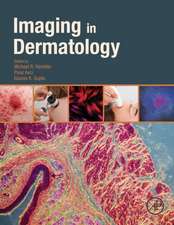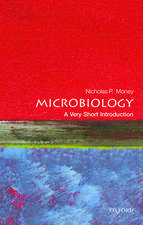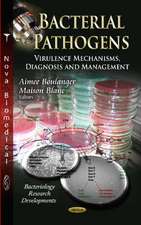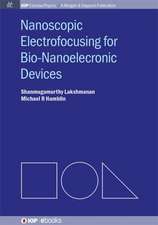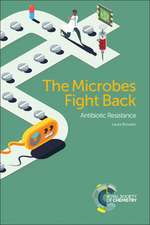Photodynamic Inactivation of Microbial Pathogens: Medical and Environmental Applications: Comprehensive Series in Photochemical & Photobiological Sciences
Editat de Michael R. Hamblin, Giulio Jori, Donat-P Haderen Limba Engleză Hardback – 31 mai 2011
Photodynamic therapy (PDT) was discovered over one hundred years ago after observing the death of microorganisms upon exposure to dyes and light. It is the combination of non-toxic dyes and harmless visible light that, in the presence of oxygen, produce highly toxic reactive species. The principal medical application during the last century was in cancer therapy but, in these days of rising antibiotic resistance, PDT shows increasing promise as an alternative approach to treating infections. PDT has also been used in blood product sterilization, peridontology, acne reduction, and the treatment of viral lesions such as those caused by human papilloma virus. It may also have potential as an environmentally friendly pesticide. This is the first and only book to comprehensively cover the use of light and photosensitising agents for controlling microbial pathogens. It provides a comprehensive and up-to-date coverage of an emerging field. There are several chapters on the design of antimicrobial photosensitizers, their use to kill pathogenic organisms and their success in treating infections in animal models. It has long been known that gram-positive bacteria are highly susceptible to photoinactivation but the book also discusses means of widening the range of microorganisms that can be tackled by PDT. Edited by two pioneers in the application of PDT to medical and environmental issues, this book covers the basic science, translational research in animals, and the clinical applications in various medical specialities. It represents an indispensable resource for microbiologists and infectious disease doctors as well as dentists, dermatologists, gastroenterologists and transfusion specialists.
Preț: 1705.14 lei
Preț vechi: 1794.88 lei
-5% Nou
Puncte Express: 2558
Preț estimativ în valută:
326.32€ • 354.33$ • 274.11£
326.32€ • 354.33$ • 274.11£
Carte tipărită la comandă
Livrare economică 22 aprilie-06 mai
Preluare comenzi: 021 569.72.76
Specificații
ISBN-13: 9781849731447
ISBN-10: 1849731446
Pagini: 434
Dimensiuni: 162 x 237 x 30 mm
Greutate: 0.79 kg
Editura: Royal Society Of Chemistry
Seriile Comprehensive Series in Photochemical & Photobiological Sciences, Comprehensive Series in Photochemistry and Photobiology
ISBN-10: 1849731446
Pagini: 434
Dimensiuni: 162 x 237 x 30 mm
Greutate: 0.79 kg
Editura: Royal Society Of Chemistry
Seriile Comprehensive Series in Photochemical & Photobiological Sciences, Comprehensive Series in Photochemistry and Photobiology
Cuprins
Antimicrobial Photodynamic Therapy: Basic Principles; Phenothiazinium Salts as Antimicrobial Photosensitising Agents; Approaches to Kill Gram-negative Bacteria by Photosensitized Processes; Innovative design of antimicrobial photosensitizers; Porphyrins as antimicrobial photosensitizing agents; Fullerene Derivatives as Antimicrobial Photosensitising Agents; Photosensitiser Delivery for Photodynamic Antimicrobial Chemotherapy; Photodynamic therapy of localized infections in animal models; Pathogen Reduction In Blood For Transfusion Using Photodynamic Treatments; PDT for Acne; PDT for Viral Lesions; PDT For Cutaneous Leishmaniasis; Antimicrobial Photodynamic Therapy (aPDT) for oral infections; Photodynamic antifungal chemotherapy; Photodynamic Therapy for Wound Infections; Photodynamic Therapy for Helicobacter pylori Infections; Inactivation Of Microbial Pathogens By Photosensitised Processes: Environmental Applications; Subject Index
Notă biografică
Dr Michael R. Hamblin is a Principal Investigator at the Wellman Center for Photomedicine at Massachusetts General Hospital and an Associate Professor of Dermatology at Harvard Medical School. He received his PhD in synthetic organic chemistry from Trent University in England. His interests lie in photodynamic therapy for infections, cancer, and heart disease and also in low-level light therapy for wound healing, arthritis, traumatic brain injury and hair regrowth. His research program is supported by NIH, CDMRP and CIMIT among others. He has published over 125 peer-reviewed articles, over 120 conference proceedings, book chapters and international abstracts, and holds 8 patents.
Textul de pe ultima copertă
Photodynamic therapy (PDT) was discovered over one hundred years ago after observing the death of microorganisms upon exposure to dyes and light. It is the combination of non-toxic dyes and harmless visible light that, in the presence of oxygen, produce highly toxic reactive species. The principal medical application during the last century was in cancer therapy but, in these days of rising antibiotic resistance, PDT shows increasing promise as an alternative approach to treating infections. PDT has also been used in blood product sterilization, peridontology, acne reduction, and the treatment of viral lesions such as those caused by human papilloma virus. It may also have potential as an environmentally friendly pesticide. This is the first and only book to comprehensively cover the use of light and photosensitising agents for controlling microbial pathogens. It provides a comprehensive and up-to-date coverage of an emerging field. There are several chapters on the design of antimicrobial photosensitizers, their use to kill pathogenic organisms and their success in treating infections in animal models. It has long been known that gram-positive bacteria are highly susceptible to photoinactivation but the book also discusses means of widening the range of microorganisms that can be tackled by PDT. Edited by two pioneers in the application of PDT to medical and environmental issues, this book covers the basic science, translational research in animals, and the clinical applications in various medical specialities. It represents an indispensable resource for microbiologists and infectious disease doctors as well as dentists, dermatologists, gastroenterologists and transfusion specialists.
Descriere
"Photodymanic Inactivation of Microbial Pathogens" is the first book to comprehensively cover the use of light and photosensitizing agents for controlling the population of microbial pathogens.










